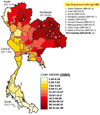Opisthorchiasis and Opisthorchis-associated cholangiocarcinoma in Thailand and Laos
- PMID: 20655862
- PMCID: PMC3010517
- DOI: 10.1016/j.actatropica.2010.07.006
Opisthorchiasis and Opisthorchis-associated cholangiocarcinoma in Thailand and Laos
Abstract
Liver fluke infection caused by Opisthorchis viverrini is a major public health problem in Thailand and the Lao People's Democratic Republic (Lao PDR; Laos). Currently, more than 600 million people are at risk of infection with these fish-borne trematodes and/or their close relatives. Opisthorchiasis has been studied extensively in Thailand, where about 8 million people are infected with the liver fluke. Here we review the pathogenesis, control and re-emergence of O. viverrini infection, in particular in Thailand and, to a lesser extent in Lao PDR given the contiguous geographical range of O. viverrini through these two regions. We also review the association of O. viverrini infection and cholangiocarcinoma, bile duct cancer, and highlight new findings on pathogenesis of liver fluke-induced cholangiocarcinogenesis. Last, we comment on national control strategies in Thailand for the control of O. viverrini infection aimed at reduction in the prevalence of O. viverrini-associated liver cancer in the longer term.
Copyright © 2010 Elsevier B.V. All rights reserved.
Figures




References
-
- Ando K, Sithithaworn P, Nuchjungreed C, Tesana S, Srisawangwong T, Limviroj W, Chinzei Y. Nucleotide sequence of mitochondrial CO I and ribosomal ITS II genes of Opisthorchis viverrini in northeast Thailand. Southeast Asian J Trop Med Public Health. 2001;32 Suppl 2:17–22. - PubMed
Publication types
MeSH terms
Grants and funding
LinkOut - more resources
Full Text Sources
Medical

